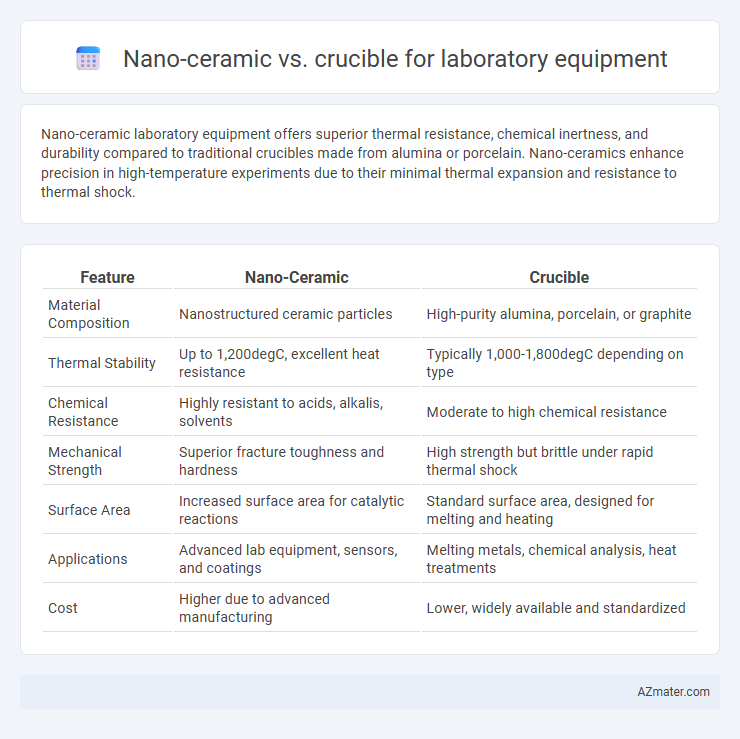Nano-ceramic laboratory equipment offers superior thermal resistance, chemical inertness, and durability compared to traditional crucibles made from alumina or porcelain. Nano-ceramics enhance precision in high-temperature experiments due to their minimal thermal expansion and resistance to thermal shock.
Table of Comparison
| Feature | Nano-Ceramic | Crucible |
|---|---|---|
| Material Composition | Nanostructured ceramic particles | High-purity alumina, porcelain, or graphite |
| Thermal Stability | Up to 1,200degC, excellent heat resistance | Typically 1,000-1,800degC depending on type |
| Chemical Resistance | Highly resistant to acids, alkalis, solvents | Moderate to high chemical resistance |
| Mechanical Strength | Superior fracture toughness and hardness | High strength but brittle under rapid thermal shock |
| Surface Area | Increased surface area for catalytic reactions | Standard surface area, designed for melting and heating |
| Applications | Advanced lab equipment, sensors, and coatings | Melting metals, chemical analysis, heat treatments |
| Cost | Higher due to advanced manufacturing | Lower, widely available and standardized |
Introduction to Laboratory Crucibles and Nano-Ceramic Materials
Laboratory crucibles are essential containers designed to withstand extremely high temperatures during chemical analysis, typically made from materials like porcelain, alumina, or platinum to ensure durability and chemical resistance. Nano-ceramic materials, composed of nanoparticles with enhanced mechanical strength and thermal stability, offer superior heat resistance and reduced contamination risks compared to traditional crucibles. Their nano-scale structure provides increased surface area and improved thermal conductivity, making nano-ceramic crucibles ideal for advanced laboratory applications requiring precision and reliability.
Material Composition: Nano-Ceramic vs Traditional Crucibles
Nano-ceramic laboratory equipment features advanced materials such as silicon nitride or zirconia, providing superior thermal stability and chemical resistance compared to traditional crucibles made from alumina or porcelain. The enhanced molecular structure of nano-ceramics allows for higher durability, reduced thermal expansion, and improved resistance to corrosion and contamination during high-temperature experiments. Traditional crucibles, while effective for routine applications, often degrade faster under extreme conditions due to their coarser material composition and lower mechanical strength.
Thermal Stability and Heat Resistance Comparison
Nano-ceramic laboratory equipment exhibits superior thermal stability withstanding temperatures up to 1600degC without deformation, ensuring precise experimental conditions. Crucibles made from traditional materials like porcelain or alumina often have lower heat resistance, typically functioning effectively up to 1200degC but with higher risks of cracking under rapid temperature changes. The enhanced heat resistance and thermal shock tolerance of nano-ceramic materials significantly improve durability and reliability in high-temperature laboratory applications.
Chemical Resistance in Laboratory Environments
Nano-ceramic laboratory equipment offers superior chemical resistance compared to traditional crucible materials, effectively withstanding aggressive acids, alkalis, and solvents without degradation. This enhanced resistance minimizes contamination risks and extends the lifespan of lab apparatus in harsh chemical environments. Crucibles, typically made from materials like porcelain or metal, may suffer corrosion or chemical breakdown under similar conditions, limiting their durability and performance during prolonged chemical exposure.
Durability and Lifespan: Which Lasts Longer?
Nano-ceramic laboratory equipment offers superior durability due to its enhanced resistance to thermal shock, chemical corrosion, and mechanical wear, resulting in a longer lifespan compared to traditional crucibles. Crucibles, often made of materials like porcelain or graphite, tend to degrade faster under intense laboratory conditions, especially when exposed to high temperatures and aggressive chemicals. The advanced nano-ceramic structure ensures extended usability and reduced replacement frequency, making it a more cost-effective choice for demanding laboratory environments.
Cost Analysis: Nano-Ceramic vs Conventional Crucibles
Nano-ceramic crucibles offer enhanced durability and chemical resistance, reducing replacement frequency and long-term costs in laboratory settings compared to conventional crucibles. Although initial investment for nano-ceramic crucibles is higher, their superior thermal stability and resistance to contamination minimize operational expenses and improve experimental accuracy. Cost analysis reveals that the total cost of ownership for nano-ceramic crucibles becomes lower over time due to decreased maintenance and better performance efficiency.
Performance in High-Temperature Applications
Nano-ceramic materials exhibit superior thermal stability and chemical resistance compared to traditional crucibles, making them ideal for high-temperature laboratory applications reaching up to 1600degC. Their enhanced durability reduces contamination risks and ensures consistent sample integrity during prolonged heating processes. Crucibles, often made from alumina or porcelain, offer reliable heat resistance but typically lack the nano-scale structural advantages that improve thermal shock resistance in nano-ceramics.
Ease of Cleaning and Maintenance
Nano-ceramic laboratory equipment offers superior ease of cleaning and maintenance due to its non-porous, smooth surface that resists chemical residues and staining. Crucibles, often made from materials like porcelain or graphite, can retain residues in micro-porosities, requiring more intensive cleaning procedures. The durability and chemical inertness of nano-ceramic make it more efficient for repetitive laboratory use, minimizing downtime for maintenance.
Safety Considerations and Operational Risks
Nano-ceramic laboratory equipment offers superior thermal shock resistance and chemical inertness, reducing the risk of breakage and contamination during high-temperature experiments compared to traditional crucibles. Crucibles, often made from graphite or porcelain, may be more susceptible to thermal cracking and chemical reactions, posing higher operational hazards such as spills or equipment failure. Prioritizing nano-ceramic materials enhances overall lab safety by minimizing exposure to hazardous substances and improving durability under rigorous experimental conditions.
Choosing the Right Crucible: Application-Specific Recommendations
Nano-ceramic crucibles offer superior chemical resistance and thermal stability, making them ideal for high-temperature applications requiring minimal contamination. Crucibles made from traditional materials like porcelain or quartz suit general laboratory use but may lack the durability needed for aggressive reactions. Selecting the right crucible depends on factors such as chemical compatibility, thermal requirements, and the specific nature of the reactions being conducted.

Infographic: Nano-ceramic vs Crucible for Laboratory equipment
 azmater.com
azmater.com